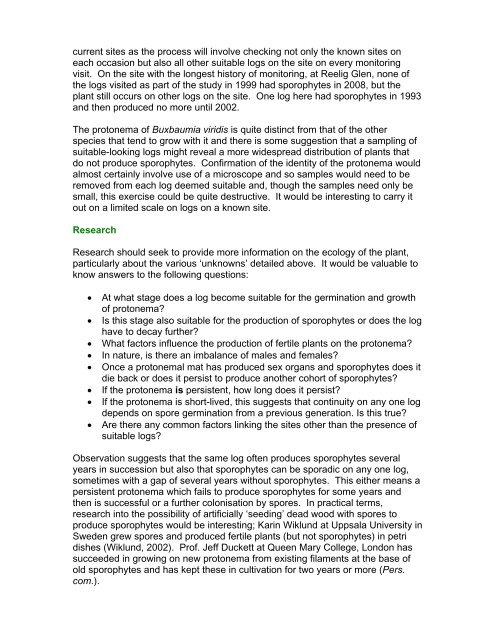Buxbaumia viridis leaflet - Plantlife
Buxbaumia viridis leaflet - Plantlife
Buxbaumia viridis leaflet - Plantlife
You also want an ePaper? Increase the reach of your titles
YUMPU automatically turns print PDFs into web optimized ePapers that Google loves.
current sites as the process will involve checking not only the known sites oneach occasion but also all other suitable logs on the site on every monitoringvisit. On the site with the longest history of monitoring, at Reelig Glen, none ofthe logs visited as part of the study in 1999 had sporophytes in 2008, but theplant still occurs on other logs on the site. One log here had sporophytes in 1993and then produced no more until 2002.The protonema of <strong>Buxbaumia</strong> <strong>viridis</strong> is quite distinct from that of the otherspecies that tend to grow with it and there is some suggestion that a sampling ofsuitable-looking logs might reveal a more widespread distribution of plants thatdo not produce sporophytes. Confirmation of the identity of the protonema wouldalmost certainly involve use of a microscope and so samples would need to beremoved from each log deemed suitable and, though the samples need only besmall, this exercise could be quite destructive. It would be interesting to carry itout on a limited scale on logs on a known site.ResearchResearch should seek to provide more information on the ecology of the plant,particularly about the various ‘unknowns’ detailed above. It would be valuable toknow answers to the following questions:• At what stage does a log become suitable for the germination and growthof protonema?• Is this stage also suitable for the production of sporophytes or does the loghave to decay further?• What factors influence the production of fertile plants on the protonema?• In nature, is there an imbalance of males and females?• Once a protonemal mat has produced sex organs and sporophytes does itdie back or does it persist to produce another cohort of sporophytes?• If the protonema is persistent, how long does it persist?• If the protonema is short-lived, this suggests that continuity on any one logdepends on spore germination from a previous generation. Is this true?• Are there any common factors linking the sites other than the presence ofsuitable logs?Observation suggests that the same log often produces sporophytes severalyears in succession but also that sporophytes can be sporadic on any one log,sometimes with a gap of several years without sporophytes. This either means apersistent protonema which fails to produce sporophytes for some years andthen is successful or a further colonisation by spores. In practical terms,research into the possibility of artificially ‘seeding’ dead wood with spores toproduce sporophytes would be interesting; Karin Wiklund at Uppsala University inSweden grew spores and produced fertile plants (but not sporophytes) in petridishes (Wiklund, 2002). Prof. Jeff Duckett at Queen Mary College, London hassucceeded in growing on new protonema from existing filaments at the base ofold sporophytes and has kept these in cultivation for two years or more (Pers.com.).
















